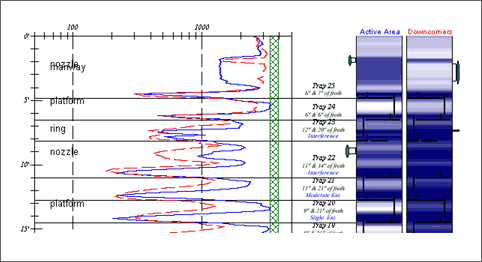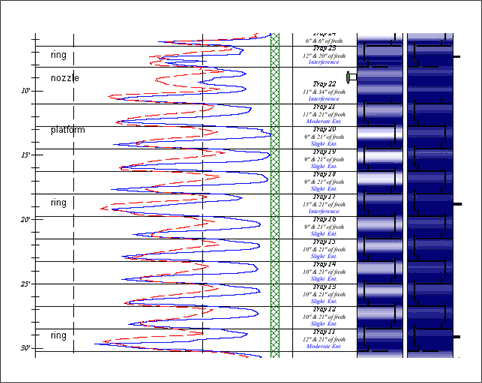SCAN RESULTS AND ANALYSIS:
We were informed that the column had experienced operational difficulties prior to our scan. The goal of the scan was to verify operational conditions at the present rates. Due to delays with the rain, the active area scan (blue solid) did not follow the downcomer scan immeadiately. The Downcomer Scan (red dash) began at 11:22. The Active Area Scan (blue solid) began at 15:19.
As stated, all twenty-five trays were at the expected elevations and were all holding aerated froth. Where we encountered interference from externals/dissconnects, sometimes there is a corresponding change in density and/or froth height.
Trays 25 - 23 appeared in place holding 6” of aerated liquid. Tray 23 had interference from a ring, but it appeared to follow the same loading trend. The downcomers for these trays followed the trend from the trays, therefore, not indicating any problems except that they were relatively lightly loaded.

Trays 22 - 11 also appeared in place, but were much heavier loaded. This is most likely due to the feed above Tray 22. These trays were holding an average of 9 - 12 inches of aerated material and were operating normally to mostly slight entrainment.

The main point of interest for this section was the downcomer loadings. All of the downcomers were fairly evenly loaded (red dash). There was a typical reduction in the vapor spaces for the downcomers, buy nothing that would indicate a specific downcomer as a problem. Overall, the downcomers indicated typical responses.
Trays 10 - 3 were operating flooded on the active area scan (blue solid). The approximate time we were in that section of the column was 16:00. If a pressure swing can not be identified as the root cause, then some other mechanical/process problem could exist in this area.
The downcomer scan (red dash) done earlier in the day did not indicate any significant change for this section. However, this is only valid information for the time of the downcomer scan. Changes could have taken place between the scans.

The Chimney Tray was in place, but was not holding a dense non-aerated liquid. If this tray is designed to hold a liquid level, it should be considered suspect for possible damage.

The bottoms liquid level was observed approximately 7.5 feet below the Chimney Tray.


